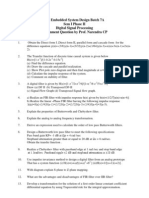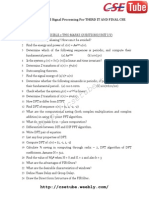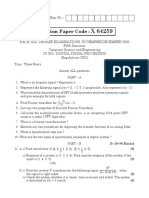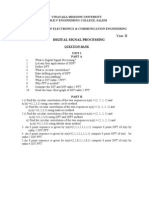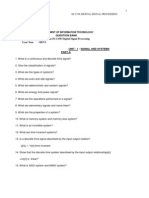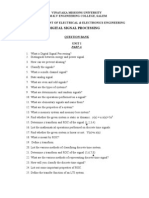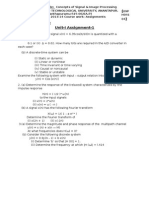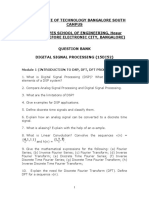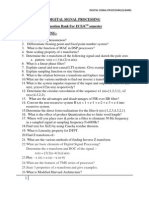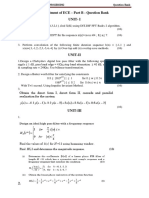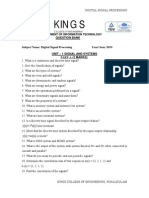PART A (10 X 2 20 Marks)
PART A (10 X 2 20 Marks)
Uploaded by
dhakaruCopyright:
Available Formats
PART A (10 X 2 20 Marks)
PART A (10 X 2 20 Marks)
Uploaded by
dhakaruOriginal Description:
Original Title
Copyright
Available Formats
Share this document
Did you find this document useful?
Is this content inappropriate?
Copyright:
Available Formats
PART A (10 X 2 20 Marks)
PART A (10 X 2 20 Marks)
Uploaded by
dhakaruCopyright:
Available Formats
PART A (10 x 2 =20 marks)
PART B (5 x 16 = 80)
B.E/B.Tech DEGREE EXAMINATION,NOV/DEC 2009 SEVENTH SEMESTER COMPUTER SCIENCE AND ENGINEERING IT-1252-DIGITAL SIGNAL PROCESSING PART A 1. what are the advantages of DSP? 2. define impulse signal 3. calculate the DFT sequence x(n)={1,1,-2,-2} 4. list any four properties of DFT 5. compare digital and analog filter 6. sketch the mapping of s-plane and z-plane in bilinear transformation 7. write the steps involved in FIR filter design 8. write the expression for Kaiser window function 9. what are the different formats of fixed point representation? 10. how overflow limit cycles can be eliminated? PART B 11.a) test the stability and causality of the following system (i) y(n)=cosx(n) (8) (ii) y(n)=x(-n-2) (8) OR b) find the one sided z-transform of discrete sequences generated by mathematically sampling of the following continuous time function (i)x(t)=sin wt (8) (ii)x(t)=cos wt (8) 12.a)(i) calculate the percentage of savings in calculation in computing a 512-point using radix-2 FFT when compared to discrete DFT (8) (ii) draw and explain the basic butterfly diagram of DIF radix-2 FFT (8) OR b) an 8-point sequence is given by x(n)={2,2,2,2,1,1,1,1} compute 8 point DFT of x(n) by (i) Radix-2 DIT-FFT (8) (ii) Radix-2 DIF-FFT (8) also sketch the magnitude and phase spectrum
13.a) apply the bilinear transformation for the following: (i)Ha(s)=2/(s+1)(s+2) with T=1 sec find out H(z) (8) (i)Ha(s)=2s/s2+0.2s+1 with T=1 sec find out H(z) (8) OR b)(i) compare the impulse invariant and bilinear transformation.(6) (ii) explain the design procedure for lowpass digital butterworth IIR filter(10) 14.a) design a lowpass filter using rectangular window by taking 9 samples of w(n) and with cutoff frequency of 1.2 radians/sec (16) OR b) design a linear phase lowpass FIR filter with cutoff frequency of 90 rad/sec using frequency sampling techniques.(Take N=17) (16) 15.a)(i) compare the fixed point and floating point arithmetic, representation and operations. (6) (ii) what is meant by product quantization error? Draw and explain the product quantization noise model of IIR system with two first order section in cascade. (10) OR b)(i) what are zero I/P and overflow limit cycle? (6) (ii) explain the characteristics of the limit cycle in the filter y(n)=0.95y(n-1)+x(n). determine the dead band of filter. (10)
You might also like
- DSP QuestionsDocument8 pagesDSP Questionsjjshree79No ratings yet
- DTSPDocument4 pagesDTSPmonisa kannanNo ratings yet
- Digital Signal ProcessingDocument7 pagesDigital Signal ProcessingAhsan MalikNo ratings yet
- DSP AssgnDocument2 pagesDSP AssgnShashank M Chanmal100% (1)
- Sixth Semester B Tech (Enginee Ing) Degree Examination December 2 10Document2 pagesSixth Semester B Tech (Enginee Ing) Degree Examination December 2 10Abhishek EkNo ratings yet
- Digital Signal Processing Question BankDocument4 pagesDigital Signal Processing Question BanksharlisreeNo ratings yet
- DSP Previous PapersDocument8 pagesDSP Previous PapersecehodaietNo ratings yet
- DSP PDFDocument0 pagesDSP PDFvelkarthi92No ratings yet
- Question Paper Code:: Reg. No.Document3 pagesQuestion Paper Code:: Reg. No.DhariniJeevanandamNo ratings yet
- EC2314Document3 pagesEC2314Rakesh Kumar DNo ratings yet
- Unit I Discrete Fourier Transform Part B April 2018) : Ec 8553 - Discrete Time Signal Processing Question BankDocument8 pagesUnit I Discrete Fourier Transform Part B April 2018) : Ec 8553 - Discrete Time Signal Processing Question BankDr.EZHILARASI PNo ratings yet
- Question Paper Code:: Reg. No.Document2 pagesQuestion Paper Code:: Reg. No.Naveen KumarNo ratings yet
- Question Bank: Subject Code: Subject NameDocument5 pagesQuestion Bank: Subject Code: Subject NamemsurendiranNo ratings yet
- Question Bank Name of Subject: EC8553 Discrete Time Signal Processing Unit I Discrete Fourier TransformDocument5 pagesQuestion Bank Name of Subject: EC8553 Discrete Time Signal Processing Unit I Discrete Fourier TransformjeevaNo ratings yet
- Rajastan College of Engineering For Women: Digital Signal ProcessingDocument7 pagesRajastan College of Engineering For Women: Digital Signal Processingchandra1985No ratings yet
- Cusat DSP Question PaperDocument14 pagesCusat DSP Question PaperSabith PockerNo ratings yet
- B.Tech (EC, VI SEM) : Ii) All Questions Carry Equal MarksDocument2 pagesB.Tech (EC, VI SEM) : Ii) All Questions Carry Equal MarksRajNo ratings yet
- EC6502-Principal of Digital Signal Processing - 2013 - Regulation PDFDocument13 pagesEC6502-Principal of Digital Signal Processing - 2013 - Regulation PDFSuba Sara SubaNo ratings yet
- Unit I Two Marks:: Infinite Impulse Response Digital Filters & Unit-Iii: Finite Impulse Response Digital FiltersDocument3 pagesUnit I Two Marks:: Infinite Impulse Response Digital Filters & Unit-Iii: Finite Impulse Response Digital FiltersMoganambal MoganaNo ratings yet
- New Microsoft Word DocumentDocument3 pagesNew Microsoft Word Documentsugesh98No ratings yet
- UntitledDocument4 pagesUntitled9710190524No ratings yet
- Question Paper Code:: Reg. No.Document3 pagesQuestion Paper Code:: Reg. No.DhariniJeevanandamNo ratings yet
- Semester: IV Year: II: Digital Signal ProcessingDocument5 pagesSemester: IV Year: II: Digital Signal ProcessingShipra ChoudharyNo ratings yet
- 2008 Regulations Question PaperDocument15 pages2008 Regulations Question PaperSivabalanNo ratings yet
- 6th sem.-EC 1358-DSPDocument8 pages6th sem.-EC 1358-DSPGautham LogarajNo ratings yet
- Digital Signal Processing (QB)Document11 pagesDigital Signal Processing (QB)MATHANKUMAR.SNo ratings yet
- CS331 Digital Signal Processing Nov Dec 2003Document3 pagesCS331 Digital Signal Processing Nov Dec 2003Chandru SekarNo ratings yet
- Digital Signal ProcessingDocument7 pagesDigital Signal ProcessingJagadeesh KumarNo ratings yet
- Concepts of Fsdsdfsignal & Image ProcessingDocument6 pagesConcepts of Fsdsdfsignal & Image ProcessingPrahlad ReddyNo ratings yet
- Ex05b - PDSP Question Paper - Te - 1Document4 pagesEx05b - PDSP Question Paper - Te - 1shankarNo ratings yet
- DSP QBDocument7 pagesDSP QBRoopa Nayak100% (1)
- Reg. No: B.Tech. Degree Examination, June 2011: (For The Candidates Admitted From The Academic Year 2007-2008 Onwards)Document3 pagesReg. No: B.Tech. Degree Examination, June 2011: (For The Candidates Admitted From The Academic Year 2007-2008 Onwards)abhinavch26No ratings yet
- Anna University:: Chennai - 600 025 Model Question PaperDocument2 pagesAnna University:: Chennai - 600 025 Model Question Papergreenis624No ratings yet
- Anna University:: Chennai - 600 025 Model Question PaperDocument2 pagesAnna University:: Chennai - 600 025 Model Question PaperHari PrasadNo ratings yet
- Question Paper Code:: (10 2 20 Marks)Document3 pagesQuestion Paper Code:: (10 2 20 Marks)Santhosh UskNo ratings yet
- Discrete Time Signal Processing Unit-Ii Question Bank Part - A (Two Marks)Document2 pagesDiscrete Time Signal Processing Unit-Ii Question Bank Part - A (Two Marks)Anonymous Ndsvh2soNo ratings yet
- Digital Signal Processing QUESTION BANKDocument5 pagesDigital Signal Processing QUESTION BANKSaran SekaranNo ratings yet
- DSP 2Document2 pagesDSP 2Sudhashree MutuswamyNo ratings yet
- Question Paper Code:: (10×2 20 Marks)Document3 pagesQuestion Paper Code:: (10×2 20 Marks)ManimegalaiNo ratings yet
- Question Bank: Discrete Fourier Transforms & Fast Fourier TransformsDocument10 pagesQuestion Bank: Discrete Fourier Transforms & Fast Fourier TransformsKeerthe VaasanNo ratings yet
- Information Technology V Sem Set 1Document2 pagesInformation Technology V Sem Set 1aniruthgsabapathyNo ratings yet
- DSP Am08Document3 pagesDSP Am08Senthil KumarNo ratings yet
- DSP Model-2Document3 pagesDSP Model-2EEE DEPTNo ratings yet
- Department of ECE - Part B - Question Bank Unit-IDocument2 pagesDepartment of ECE - Part B - Question Bank Unit-ISelva KumarasamyNo ratings yet
- Department of ECE - Part B - Question Bank Unit-IDocument2 pagesDepartment of ECE - Part B - Question Bank Unit-ISelva Kumarasamy100% (1)
- DSPDocument2 pagesDSPSyed NajeebNo ratings yet
- DSP EC 2302 16 Mark QuestionsDocument3 pagesDSP EC 2302 16 Mark QuestionsVenkat RamananNo ratings yet
- DSP QBDocument8 pagesDSP QBNithya VijayaNo ratings yet
- Question Paper Code:: Reg. No.Document4 pagesQuestion Paper Code:: Reg. No.Varun RithvikNo ratings yet
- Anna University Digital Signal Processing Question BankDocument6 pagesAnna University Digital Signal Processing Question Banks.ranjithNo ratings yet
- New Microsoft Word DocumentDocument12 pagesNew Microsoft Word DocumenthafizrahimmitNo ratings yet
- IT6502-Digital Signal ProcessingDocument10 pagesIT6502-Digital Signal ProcessingMadhumitha RajasekaranNo ratings yet
- Assignment For B.Tech ECE: X N X KDocument3 pagesAssignment For B.Tech ECE: X N X KTanmay GoelNo ratings yet
- DSP Question BankDocument5 pagesDSP Question Bank19R21A04H8 VANKA AJAY BABUNo ratings yet
- Question Papper Code: 11332: B.E./B.Tech. Degree Examination, May/June 2012 Fifth SemesterDocument3 pagesQuestion Papper Code: 11332: B.E./B.Tech. Degree Examination, May/June 2012 Fifth SemesterMaddy TrichyNo ratings yet
- DSP Imp QuestionsDocument2 pagesDSP Imp QuestionsAbbas ShaikNo ratings yet
- Digital Signal ProcessingDocument6 pagesDigital Signal ProcessingTim LeeNo ratings yet
- Oldexams DSPDocument25 pagesOldexams DSP29377No ratings yet
- Discrete Wavelet Transform: A Signal Processing ApproachFrom EverandDiscrete Wavelet Transform: A Signal Processing ApproachRating: 5 out of 5 stars5/5 (2)
- Advanced Chipless RFID: MIMO-Based Imaging at 60 GHz - ML DetectionFrom EverandAdvanced Chipless RFID: MIMO-Based Imaging at 60 GHz - ML DetectionNo ratings yet
- DDDDDocument2 pagesDDDDdhakaruNo ratings yet
- Object Oriented Analysis and Design Using UMLDocument271 pagesObject Oriented Analysis and Design Using UMLdhakaru100% (1)
- Object Oriented Analysis and Design Using UMLDocument129 pagesObject Oriented Analysis and Design Using UMLvsudarsaanNo ratings yet
- Source CodeDocument6 pagesSource CodedhakaruNo ratings yet
- Object-Oriented Systems Development Life CycleDocument32 pagesObject-Oriented Systems Development Life CycleAarthi VijayKumarNo ratings yet



